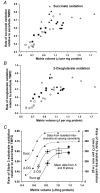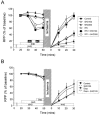The effects of ischaemic preconditioning, diazoxide and 5-hydroxydecanoate on rat heart mitochondrial volume and respiration
- PMID: 12482899
- PMCID: PMC2290722
- DOI: 10.1113/jphysiol.2002.031484
The effects of ischaemic preconditioning, diazoxide and 5-hydroxydecanoate on rat heart mitochondrial volume and respiration
Abstract
Studies with different ATP-sensitive potassium (K(ATP)) channel openers and blockers have implicated opening of mitochondrial K(ATP) (mitoK(ATP)) channels in ischaemic preconditioning (IPC). It would be predicted that this should increase mitochondrial matrix volume and hence respiratory chain activity. Here we confirm this directly using mitochondria rapidly isolated from Langendorff-perfused hearts. Pre-ischaemic matrix volumes for control and IPC hearts (expressed in microl per mg protein +/- S.E.M., n = 6), determined with (3)H(2)O and [(14)C]sucrose, were 0.67 +/- 0.02 and 0.83 +/- 0.04 (P < 0.01), respectively, increasing to 1.01 +/- 0.05 and 1.18 +/- 0.02 following 30 min ischaemia (P < 0.01) and to 1.21 +/- 0.13 and 1.26 +/- 0.25 after 30 min reperfusion. Rates of ADP-stimulated (State 3) and uncoupled 2-oxoglutarate and succinate oxidation increased in parallel with matrix volume until maximum rates were reached at volumes of 1.1 microl ml(-1) or greater. The mitoK(ATP) channel opener, diazoxide (50 microM), caused a similar increase in matrix volume, but with inhibition rather than activation of succinate and 2-oxoglutarate oxidation. Direct addition of diazoxide (50 microM) to isolated mitochondria also inhibited State 3 succinate and 2-oxoglutarate oxidation by 30 %, but not that of palmitoyl carnitine. Unexpectedly, treatment of hearts with the mitoK(ATP) channel blocker 5-hydroxydecanoate (5HD) at 100 or 300 microM, also increased mitochondrial volume and inhibited respiration. In isolated mitochondria, 5HD was rapidly converted to 5HD-CoA by mitochondrial fatty acyl CoA synthetase and acted as a weak substrate or inhibitor of respiration depending on the conditions employed. These data highlight the dangers of using 5HD and diazoxide as specific modulators of mitoK(ATP) channels in the heart.
Figures






Similar articles
-
K(ATP) channel-independent targets of diazoxide and 5-hydroxydecanoate in the heart.J Physiol. 2002 Aug 1;542(Pt 3):735-41. doi: 10.1113/jphysiol.2002.023960. J Physiol. 2002. PMID: 12154175 Free PMC article.
-
MitoK(ATP)-dependent changes in mitochondrial volume and in complex II activity during ischemic and pharmacological preconditioning of Langendorff-perfused rat heart.J Bioenerg Biomembr. 2006 Apr;38(2):101-12. doi: 10.1007/s10863-006-9016-3. Epub 2006 Sep 21. J Bioenerg Biomembr. 2006. PMID: 17031549
-
P1075 opens mitochondrial K(ATP) channels and generates reactive oxygen species resulting in cardioprotection of rabbit hearts.J Mol Cell Cardiol. 2003 Sep;35(9):1035-42. doi: 10.1016/s0022-2828(03)00151-2. J Mol Cell Cardiol. 2003. PMID: 12967626
-
Mitochondrial ATP-dependent potassium channels. Viable candidate effectors of ischemic preconditioning.Ann N Y Acad Sci. 1999 Jun 30;874:27-37. doi: 10.1111/j.1749-6632.1999.tb09222.x. Ann N Y Acad Sci. 1999. PMID: 10415518 Review.
-
Mitochondrial potassium transport: the role of the mitochondrial ATP-sensitive K(+) channel in cardiac function and cardioprotection.Biochim Biophys Acta. 2003 Sep 30;1606(1-3):1-21. doi: 10.1016/s0005-2728(03)00109-9. Biochim Biophys Acta. 2003. PMID: 14507424 Review.
Cited by
-
Cardioprotection afforded by chronic exercise is mediated by the sarcolemmal, and not the mitochondrial, isoform of the KATP channel in the rat.J Physiol. 2005 Dec 15;569(Pt 3):913-24. doi: 10.1113/jphysiol.2005.095729. Epub 2005 Oct 13. J Physiol. 2005. PMID: 16223762 Free PMC article.
-
Diazoxide-induced respiratory inhibition - a putative mitochondrial K(ATP) channel independent mechanism of pharmacological preconditioning.Mol Cell Biochem. 2007 Jan;294(1-2):11-8. doi: 10.1007/s11010-005-9066-6. Epub 2006 Nov 29. Mol Cell Biochem. 2007. PMID: 17136444
-
Study of the mechanism of action of diazoxide on rat heart mitochondria under calcium loading.Dokl Biochem Biophys. 2006 May-Jun;408:133-7. doi: 10.1134/s1607672906030070. Dokl Biochem Biophys. 2006. PMID: 16913412 No abstract available.
-
Minoxidil opens mitochondrial K(ATP) channels and confers cardioprotection.Br J Pharmacol. 2004 Jan;141(2):360-6. doi: 10.1038/sj.bjp.0705613. Epub 2003 Dec 22. Br J Pharmacol. 2004. PMID: 14691056 Free PMC article.
-
Substrate-dependent modulation of oxidative phosphorylation in isolated mitochondria following in vitro hypoxia and reoxygenation injury.Exp Clin Cardiol. 2013 Spring;18(2):158-60. Exp Clin Cardiol. 2013. PMID: 23940443 Free PMC article.
References
-
- Baines CP, Cohen MV, Downey JM. Signal transduction in ischemic preconditioning: The role of kinases and mitochondrial K-ATP channels. Journal of Cardiovascular Electrophysiology. 1999;10:741–754. - PubMed
-
- Baines CP, Goto M, Downey JM. Oxygen radicals released during ischemic preconditioning contribute to cardioprotection in the rabbit myocardium. Journal of Molecular and Cellular Cardiology. 1997;29:207–216. - PubMed
-
- Bernardi P. Mitochondrial transport of cations: Channels, exchangers, and permeability transition. Physiological Reviews. 1999;79:1127–1155. - PubMed
-
- Cohen MV, Yang XM, Liu GS, Heusch G, Downey JM. Acetylcholine, bradykinin, opioids, and phenylephrine, but not adenosine, trigger preconditioning by generating free radicals and opening mitochondrial KATP channels. Circulation Research. 2001;89:273–278. - PubMed
Publication types
MeSH terms
Substances
LinkOut - more resources
Full Text Sources
Other Literature Sources

